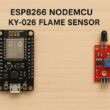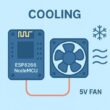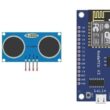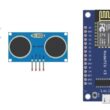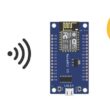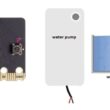Smart gas leak detection system with ESP32 and IoT
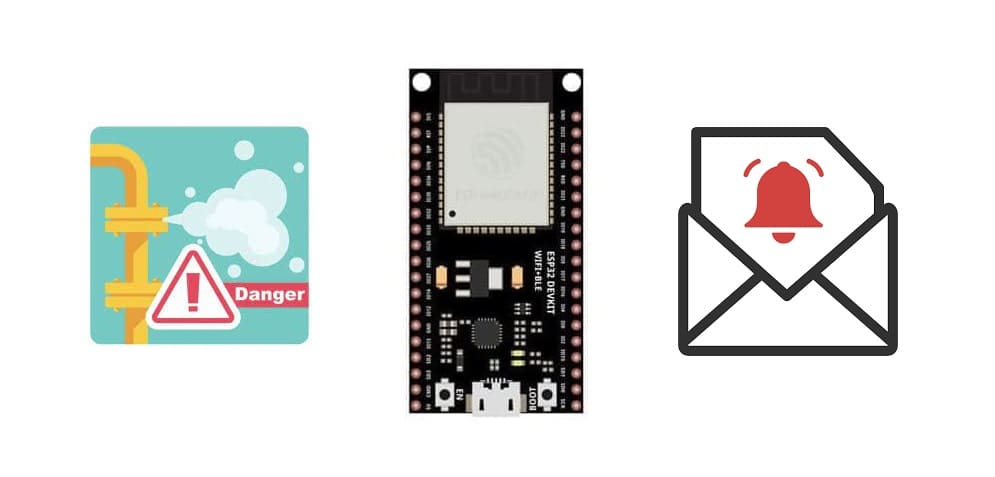
Tutorial plan
1- Role of IoT in Gas Leak Detection Systems
2- How our smart gas leak detection system works ?
3- Gas alarm system components
4- Mounting ESP32 board with MQ-4 sensor
5- Program the ESP32 board to control the system
Role of IoT in Gas Leak Detection Systems
The Internet of Things (IoT) plays a crucial role in enhancing gas leak detection systems by enabling real-time monitoring, alerting, and data analysis. Here’s a detailed explanation of its roles:
1- Real-Time Monitoring
IoT enables the continuous monitoring of gas levels using connected sensors like the MQ-4.
Data collected by the sensors is transmitted to IoT platforms or cloud services over the internet.
Users can monitor gas levels remotely through mobile apps, web dashboards, or other interfaces.
2- Instant Alerts
When a gas concentration exceeds a predefined safety threshold, the IoT system can:
Send email notifications using SMTP.
Push real-time notifications to smartphones via platforms like Blynk, Firebase, or AWS IoT.
Trigger SMS alerts using APIs like Twilio.
3- Data Logging and Analytics
IoT systems store historical gas concentration data on cloud servers.
This data can be used to:
Identify patterns and trends in gas levels.
Detect areas prone to leaks or unusual gas behavior.
Perform predictive maintenance on equipment to prevent future leaks.
4- Remote Control and Management
IoT allows remote control of safety measures, such as:
Activating ventilation systems or gas shutoff valves.
Turning off power supplies to prevent sparks in a high-gas environment.
How our smart gas leak detection system works ?
A smart gas leak detection system using an ESP32 board, MQ-4 sensor, IoT, and the SMTP protocol is a robust solution for detecting and alerting users about gas leaks. Below is a detailed breakdown of how the system works and is implemented:
1. Gas Detection Using the MQ-4 Sensor
The MQ-4 sensor detects the concentration of methane and other natural gases in the air.
It outputs an analog voltage proportional to the gas concentration.
The ESP32 reads this voltage via its ADC (Analog-to-Digital Converter) pins.
A threshold level is set. If the gas concentration exceeds this level, the system triggers an alert.
2. Email Alerts via SMTP
The ESP32 uses the SMTP protocol to send email notifications to predefined recipients.
This ensures the user is notified even if they are not near the detection site.
Gas alarm system components
ESP32 Board:
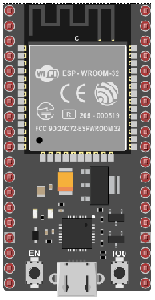
Acts as the central processing unit, handling sensor data, IoT communication, and SMTP-based alerts.
MQ-4 Sensor:
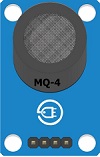
A gas sensor designed to detect methane (CH₄) and natural gases.
SMTP Protocol:
Jumper Wires:

For making temporary connections and wiring between components.
Breadboard:

A breadboard is a useful tool for creating temporary electronic circuits. It allows you to connect components without soldering.
For sending email alerts about gas leaks.
Mounting ESP32 board with MQ-4 sensor
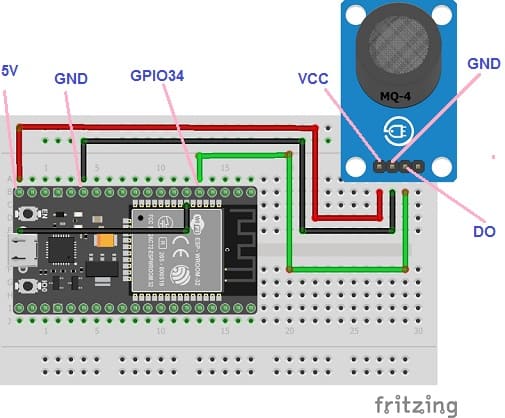
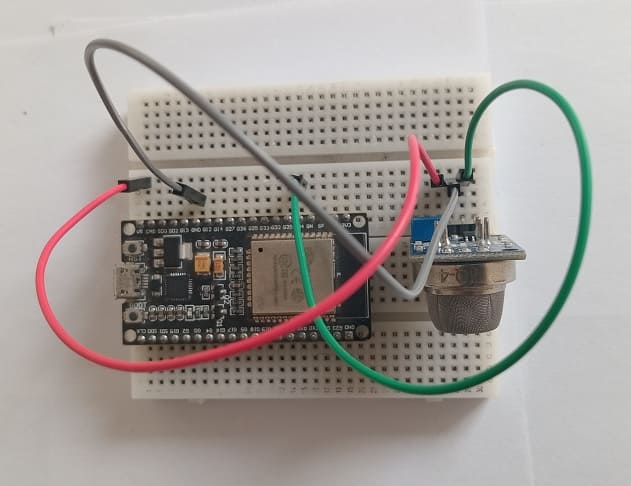
Connect the MQ-4 Sensor:
Connect the VCC pin to the 5V pin of the ESP32.
Connect the GND pin to the GND pin of the ESP32.
Connect the AOUT (analog output) pin to an ADC pin on the ESP32 (e.g., GPIO34).
Program the ESP32 board to control the system
The Micropython code includes gas detection, IoT integration, and email alerting.
You must install the two libraries :
ConnectWifi.py : Allows the ESP32 to connect to a Wi-Fi network.
umail.py : Allows sending emails via SMTP.
|
1 2 3 4 5 6 7 8 9 10 11 12 13 |
import ConnectWifi ConnectWifi.connect() import umail from machine import Pin, ADC from time import sleep gaz = ADC(Pin(34)) gaz.atten(ADC.ATTN_11DB) while True: gaz_value = flamme.read() sleep(0.1) if (gaz_value<200): smtp = umail.SMTP('smtp.gmail.com', 587, username='adresse-emetteur@gmail.com', password='**********') smtp.to('adresse-recepteur@gmail.com') smtp.send("Warning!!! there is a gas leak") smtp.quit() |


